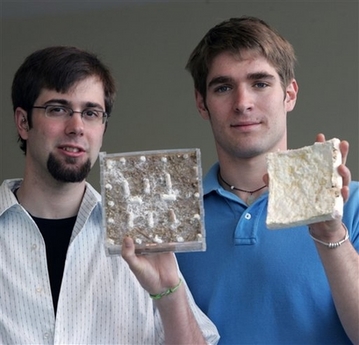Mushrooms become source for eco-building
(AP)Updated: 2007-06-25 15:14
TROY, N.Y. - Eben Bayer grew up on a farm in Vermont learning the intricacies of mushroom harvesting with his father. Now the Rensselaer Polytechnic Institute graduate is using that experience to create an organic insulation made from mushrooms.
 Gavin McIntyre, left, holds a growing sample of organic insulation, while Eben Bayer shows off the finished product, at Rensselaer Polytechnic Institute in Troy, N.Y., Thursday, May 17, 2007. [AP]  |
Combining his agricultural knowledge with colleague Gavin McIntyre's interest in sustainable technology, the two created their patented "Greensulate" formula, an organic, fire-retardant board made of water, flour, oyster mushroom spores and perlite, a mineral blend found in potting soil. They're hoping the invention will soon be part of the growing market for eco-friendly products.
Bringing the insulation to market is still at least a year away though, said McIntyre, and will require much more research and work, not to mention more sophisticated equipment and a better work space.
"We've been growing the material under our beds," said McIntyre, adding that they've applied for a grant from the National Collegiate Inventors and Innovators Alliance.
The two young developers - Bayer is 21, McIntyre 22 - graduated in May from RPI with dual majors in mechanical engineering and product design and innovation.
"I think it has a lot of potential, and it could make a big difference in people's lives," said RPI Professor Burt Swersy, whose Inventor's Studio course inspired the product's creation. "It's sustainable, and enviro-friendly, it's not based on petrochemicals and doesn't require much energy or cost to make it."
The two say recent tests at the National Institute of Standards and Technology have shown it to be competitive with most insulation brands on the market. A 1-inch-thick sample of the perlite-mushroom composite had a 2.9 R-value, the measure of a substance's ability to resist heat flow. Commercially produced fiberglass insulation typically has an R-value between 2.7 and 3.7 per inch of thickness, according to the Oak Ridge National Laboratory in Tennessee.
With a rapidly increasing global population, a limited supply of natural resources, and rising energy prices, eco-friendly housing products are selling fast. Numerous companies have carved out their niche selling "green" building supplies such as recycled fiber board and plant-based paints. The Environmental Home Center in Seattle sells an insulation made from denim scraps and another made from 100 percent recycled paper among their many green building products.
After looking through about 800 patents, though, Bayer and McIntyre realized they'd hit upon a relatively original idea. Unlike many green building products, Greensulate isn't made from pre-existing materials. It requires little energy or expense to produce because it's grown from organic material.
Here's how it works: A mixture of water, mineral
particles, starch and hydrogen peroxide are poured into 7-by-7-inch molds and
then injected with living mushroom cells. The hydrogen peroxide is used to
prevent the growth of other specimens within the material.
| 1 | 2 |  |
|
||
|
||
|
|